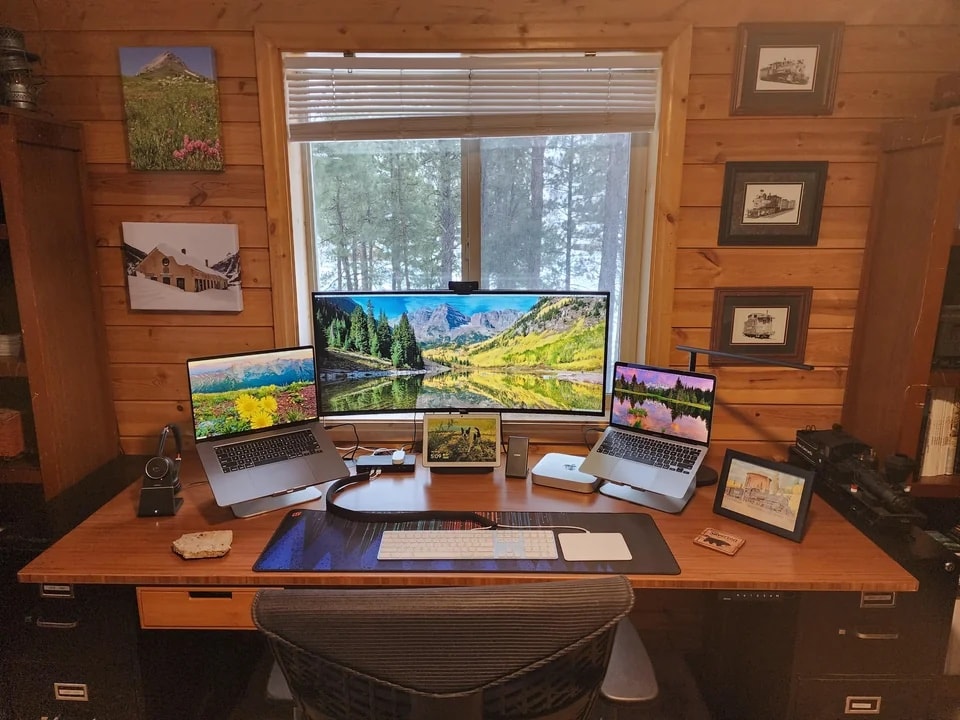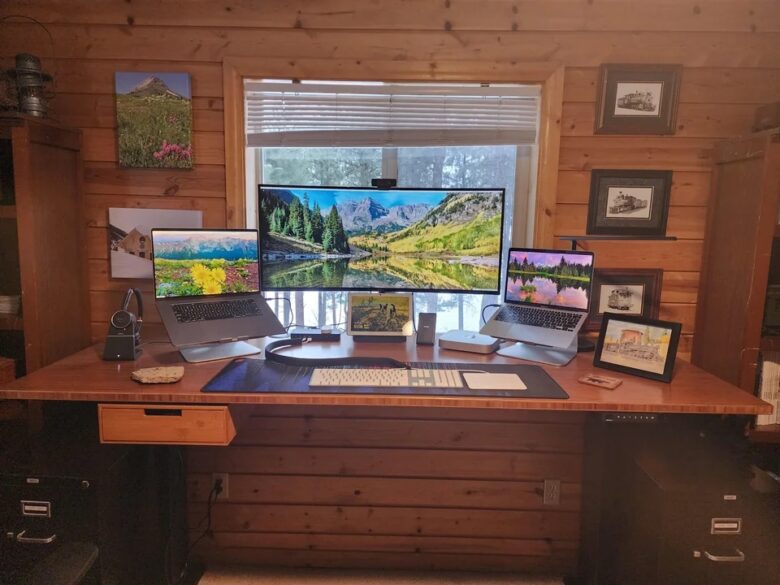

3 Macs and KVM switch keep remote worker out of trouble [Setups]
source link: https://www.cultofmac.com/805889/why-have-3-macs-and-a-kvm-switch-setups/
Go to the source link to view the article. You can view the picture content, updated content and better typesetting reading experience. If the link is broken, please click the button below to view the snapshot at that time.

3 Macs and KVM switch keep remote worker out of trouble [Setups]

Three Macs and a KVM switch with a big external monitor can be the perfect solution. Photo: [email protected]
Today’s featured computer setup employs three separate Macs — MacBook Pro, M1 MacBook Air and M1 Mac mini — connecting two of them to a big external monitor using a KVM docking station.
KVM switches are handy when you don’t want to switch cables from different computers using the same monitor and input devices. But there’s another reason the user chose to use the method.
This post contains affiliate links. Cult of Mac may earn a commission when you use our links to buy items.
Why have a MacBook Pro, MacBook Air and Mac mini with a KVM switch?
Redditor gregcoit (“GC”) showcased the homey setup with its trio of Macs and a bucolic lake view in a post entitled, “My new Uplift desk with 3 Macs and USB-C KVM.”
Naturally, commenters had questions.
“Why the 3 macs???” asked one person.
“Reasonable question,” GC replied. “The MacBook Pro on the left (from work) and the Mac mini (personal computer) share the wide-screen monitor using the KVM. Sometimes it’s nice to listen to music or podcasts during work — hence the MacBook Air on the right.”
Keeping work and play separate
But the commenter didn’t quite take that answer at face value. Snark ensued.
“You know computers can pull up more than one app at a time right?” they shot back.
“What, what?!?!?” GC feigned shock. “Of course you’re right. The real answer is that I use a VPN with the work laptop, and I don’t want to send personal emails, chats, music, YouTube, Reddit, etc., over that.”
“Correct approach, f**k spyware and monitoring,” another commenter weighed in, sticking it to the Man.
What is a KVM switch?
KVM stands for “keyboard, video, and mouse.” It’s a hardware device that lets you control multiple computers from one or more sets of keyboards, mice and monitors.
So GC’s use makes sense. Including a KVM switch makes it especially easy to switch from the Intel MacBook Pro for work, with its VPN connection, to the personal Mac mini that’s not on the VPN, while using the same 38-inch Dell UltraSharp Curved Monitor, Magic Keyboard and Magic Trackpad.
GC uses an i-tec USB-C/Thunderbolt KVM docking station. And he got it even though the Dell has a built-in KVM, but it doesn’t “play nice with Macs,” he said.
“I thought I could use that, but when the laptop is fully powered, the screen starts flashing on and off as it turns on and off the power over USB-C (at least, I think that’s the issue). Very annoying. By sending the USB-C signal through something else, that also provides the power, the monitor works so much better with Macs,” he added.
GC describes how he uses the KVM switch:
I have my 16-inch MBP piugged in as “computer 2” (where it gets power) and my mac mini plugged into “computer 1” (no power needed but you can plug a USB-C into the KVM to provide power to computer 1 if needed).
One caveat – Macs using m1 or m2 chips require a download from 1-tec.com to fix DisplayLink issues. Once I installed that, both computers work perfectly with my single monitor and everything I plug into the KVM.
The KVM has 3 USB-A ports, 2 “data” USB-C ports (the USB-C port on the back for providing power to computer 1 doesn’t appear to handle data), a headphone jack (I’m not using this) and a network port (I’m not using this either). No more switching cables for me!!!!
Both the Intel-chip-based MBP and the m1-chip-based Mac mini power my Dell UltraSharp 38 Curved Monitor – U3818DW at 3840 x 1600 @ 60 Hz. I use USB-C from both computers to the KVM (with the supplied USB-C cables).
So, USB-C between the computers and KVM, DisplayPort from there to the monitor. If I added a USB-A/B cable between the KVM and monitor, I would use the extra USB-A/USB-C ports on the monitor, but the KVM has enough ports for me.
Shop these items now:
And here’s the setup raised to standing level by the Uplift desk.
Photo: [email protected]
Computers:
Display:
Input devices:
KVM switch:
Furniture:
If you would like to see your setup featured on Cult of Mac, send some high-res pictures to [email protected]. Please provide a detailed list of your equipment. Tell us what you like or dislike about your setup, and fill us in on any special touches, challenges and plans for new additions.
Recommend
About Joyk
Aggregate valuable and interesting links.
Joyk means Joy of geeK
